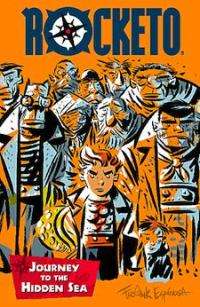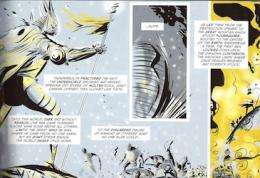Cover art from Espinosa’s Rocketo, Journey Into the Sea.
Robots and mythical creatures battle each other in cartoon-like drawings spread across a table. A crowd gathers around to take a closer look at the vibrantly colored images from the pages of the award-winning comic book Rocketo. But these people aren’t here to buy the latest edition for their comic book collection; they’re here to learn about an ancient form of storytelling that is taking on new significance in the 21st century.
Created by veteran animator Frank Espinosa in 2005, Rocketo tells the story of explorer Rocketo Garrison as he navigates through a shattered world set 2,000 years in the future. With an engaging storyline and brilliant, kinetic imagery as detailed as classical paintings, Rocketo is a prime example of contemporary graphic narrative. Graphic narrative, or illustrated storytelling, has been around almost as long as man. Cavemen painted stories on their cave walls and 18th century Japanese artists created woodblock prints of text and images, but the development of digital media in the last 40 years has elevated the form to new creative heights.
In recent years scholars have taken an interest in how graphic narratives reflect increasing hybridization in the digital age, both artistic and cultural. A group of researchers at Stanford formed the Graphic Narrative Project, an academic workshop where they could take an interdisciplinary approach to studying this dynamic art form.
“In an increasingly visual world, filled with film and easy access to millions of pictures, understanding how people conceptualize their worlds is very important,” said Vanessa Chang, a Modern Thought and Literature Ph.D. student and member of the Graphic Narrative Project. “The graphic narrative is a great way to bridge visual and narrative components.”
Because visual storytelling has so many different forms, the organizers of the Graphic Narrative Project believe interdisciplinary and intercultural analysis will help us to better understand the cultural impact of graphic narratives.
Exploring Latin American Cultural Trends through Comic Books
The Graphic Narrative Project was established in 2010 as one the Stanford Humanities Center workshops, which are designed to foster academic collaboration. Held in November, 2011, the second Graphic Narrative Project symposium was organized around the theme of comics across the Americas.
Espinosa opened the conference with a talk about his artistic process in developing Rocketo. Graphic artist Marcela Trujillo, whose comics revolve around relationships and everyday life, discussed the place of female artists in the world of Latin American comics. A series of discussion groups gave artists and academics the opportunity to delve into the prevalence of comics in Latin America and how they both reflect and shape aspects of Latin American culture.
According to Angela Becerra Vidergar, a Comparative Literature Ph.D. candidate and co-founder of The Graphic Narrative Project, one of the project’s main goals is to explore the different cultural contexts in which graphic narratives are born.
Furthermore, Vidergar added, the Latin American focus provides a new lens through which to see the form. Focusing on these comics, for example, helps scholars see trends that might have otherwise been overlooked.
“We see that there are trends in culture that are represented predominantly and it works the same with comics,” said Vidergar.
Trujillo and Espinosa both write independent comics and have the freedom to experiment with narrative and form. For instance, Trujillo writes autobiographical tales, which is a very uncommon narrative style for Chilean comics. Espinosa does a lot of experimentation with visual form.
“He uses very vibrant pastel tones, the size of the frame is longer, and the style is different. He doesn’t define forms as much,” said Haerin Shin, a Comparative Literature Ph.D. candidate and co-founder of the Graphic Narrative Project.
Espinosa’s work, Shin explained, is also unique because he demonstrates that graphic narratives, by combining reality and fantasy, can entirely recreate our world, and thus suggest a series of social and cultural implications.
A multi-layered two-page spread from Rocketo.
“Rocketo is an interesting blend of magical realism and a real rooting in history as well,” said Chang. Espinosa “includes the presence of Cuba in human history, and then makes it really fantastic…He organizes the page in a very new way, incorporating the historical as well as the magical.”
Interactive Worlds Jump off the Page
Through a combination of visual media and textual representation, graphic narratives have the capacity to create novel and highly interactive artworks. According to Vidergar, Espinosa avoids using stylized, perfected images, because he wants readers to fill in the visual gaps themselves, to use their own imaginations to actualize the work.
There is “this incredible kinetic imagery. These are static images but they move,” said one of the speakers at the event, Frederick Aldama, Arts and Humanities Distinguished Professor at Ohio State University and expert on Latin American culture.
“Graphic narratives like comics are especially good at world making,” said Chang. “They do so in very precise and evocative ways, through visual representation and language, to develop the worlds that we live in and imagine.”
Through experiments with technology and social media, comics are becoming even more interactive. One new comic has an iPad application that allows readers to scroll through images in a way that makes them appear animated. According to Shin, comics also “inspire different ways to look at technologies.” For instance, with Korean webcomics, you use the mouse to scroll down a single panel of the comic, and the images begin to look seamless. “Comics are a really good medium for visual and technological experimentation,” said Shin.
Translating Graphics Into Music
Project members meet every month to discuss a different facet of the graphic narrative. Looking ahead, they are planning presentations on an array of topics that interrelate with graphic narratives, including literature, film and cognitive science.
A special guest presents at each meeting, and in October, Mark Applebaum, a Stanford music professor and experimental composer, introduced the workshop attendees to a fascinating, if offbeat, mode of storytelling.
Applebaum takes a totally different approach to graphic narration. He combines graphics not with words, but with sounds, movements, and melodies. During his presentation, Applebaum synchronized hand gestures with electric sounds in a piece called “Aphasia.”
Applebaum translates musical scores into visual or kinetic compositions. He does not necessarily create narratives through his work, but he certainly acts as an “instigator” or “catalyzer” of narrative, according to Shin.
Through his elaborate, pictographic musical score “The Metaphysics of Notation,” an evocative work of visual art containing a series of cryptic symbols and glyphs, he encourages artists “to look at the scores and interpret them, and therefore create narratives within their given frame of reference,” said Shin.
Musicians have created sonic realizations of Applebaum's figurative scores, and one artist reimagined one of his visual compositions in poetic form.
Exploring Innovative Storytelling
In its mission to explore nontraditional forms of graphic storytelling, the Graphic Narrative Project attracts a wide scope of scholars, from art historians to archeologists, to cognitive psychologists and literary scholars.
“We bring together people who are interested in graphic narrative, but we also aim to encourage people who haven’t considered graphic narratives before, to give them the tools that they need to include these projects in their classrooms,” said Vidergar.
Vidergar herself taught a course on graphic narratives, and Shin incorporated graphic narratives into the class on science fiction and fantasy.
A recent Project meeting centered on a discussion of Dino Buzzati’s graphic novel “Poem Strip,” which takes artistic hybridization to the extreme. The graphic novel, set in Milan, incorporates quotations from works of literature, film, architecture, and painting, from across many different genres and ages, to weave a mythic, metaphysical tale.
A discussion in January with Barbara Tversky, former Professor of Psychology at Stanford, will delve into the power of graphic projects through cognitive psychology.
The February meeting will center on Japanese comics on Korean resistance movements, which is very unique because it diverges from traditional, Western comics.
Shin said that with “the infinite potential in combining the instantaneous and intuitive effects of visual media with the complex hermeneutics of textual representation,” the graphic novel genre certainly calls for further in-depth academic exploration.
Provided by Stanford University





















